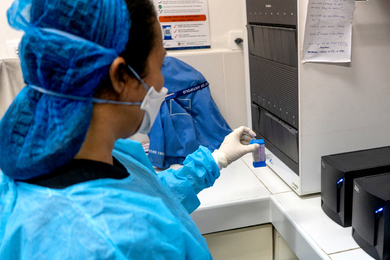5m Read
21. maaliskuuta 2025
COMMUNITY AND GLOBAL HEALTH
Article
Finding Missing TB Cases: The Philippines’ Need for Speed
The Philippines is turning the tide against tuberculosis (TB) with fast sample delivery and faster diagnostics
Finding TB cases in the Philippines is like searching for a needle in a vast archipelago. The country, which spans thousands of mountainous islands, is home to less than 1,5% of the global population but accounts for 7% of the world’s TB cases. Of an estimated 737 000 cases in the country in 2022, a third were never officially reported.1, 2
Locating these missing cases is crucial, particularly with the prevalence of multidrug-resistant (MDR) TB. “Traditional smear microscopy takes at least six months to confirm MDR TB—by then, many patients can be lost to follow-up,” says Ramon Basilio, head of the National TB Reference Laboratory. In many cases, people return to their home province or don’t survive long enough to get diagnosed.
In the past decade, molecular testing has transformed TB diagnostics in the country, cutting wait times from months to mere hours. “Patients can get a diagnosis by potentially the next afternoon and start life-saving treatment sooner,” says Basilio.
Smarter Diagnostics, Smarter Solutions
Cepheid’s GeneXpert® systems, which deliver accurate TB and MDR TB diagnoses in under 2 hours, have helped clear diagnostic bottlenecks, but there’s more to be done. “One of our major challenges is human resources for health,” notes Arnyl Araneta, program director at ACCESS TB, a regional initiative supported by the Global Fund. At rural health centers, a single doctor or nurse may be responsible for hundreds or even thousands of patients.
“One nurse doesn’t just handle TB programs,” Araneta explains. “They’re also covering HIV, malaria, immunizations—everything.”
Faced with these constraints, the Philippines TB program turned to smarter solutions. A 2015 Diagnostic Network Optimization analysis mapped the optimal placement of GeneXpert systems based on TB incidence and infrastructure (see panel at bottom of article). The results drove a surge in capacity: between 2017 and 2022, the number of GeneXpert systems increased from 317 to 1 204, reducing reliance on traditional smear microscopy by 91%.

Technologist handles TB sample preparation using the GeneXpert system.
“It has a big impact on our local communities,” says Gwendolyn Batingan, a registered medical technologist with over 18 years of experience in TB diagnostics. “It enables early detection and has reduced diagnostic delays and improved treatment management to our patients.”
Revving Up Sample Delivery
Despite progress, access gaps persist. In the Philippines, a single GeneXpert instrument typically serves ten municipalities, leaving many patients hours away from a testing site. “For far-flung areas, the nearest site is a 2 hour drive away,” says Arneta, “we ended up with a significant number of defaults for diagnosis alone.”
The solution came on two wheels. In 2017, the Philippines launched the Specimen Transport Riders (STRiders) system, a network of motorcycle couriers ferrying sputum samples from local health centers to GeneXpert sites. Within six months, the number of samples being processed doubled, and TB notifications jumped by 50%. The initiative soon expanded from five to all 17 regions of the country.

Motorcycle courier ferries sputum samples from local health centers to GeneXpert sites.
Despite major strides, gaps in health promotion and early case detection remain. Many Filipinos seek care only when severely ill, and stigma still surrounds the disease. Addressing this requires greater public awareness and education.
Still, the Philippines’ experience offers valuable lessons. The faster TB cases are found, the quicker health authorities can start to move the needle on controlling the disease.

- This article is based on original Cepheid-supported reporting done by Devex. The original report is available here. Some quotes have been paraphrased for brevity.
- https://www.theglobaleconomy.com/Philippines/population_share/
Read Next
LISÄÄ








